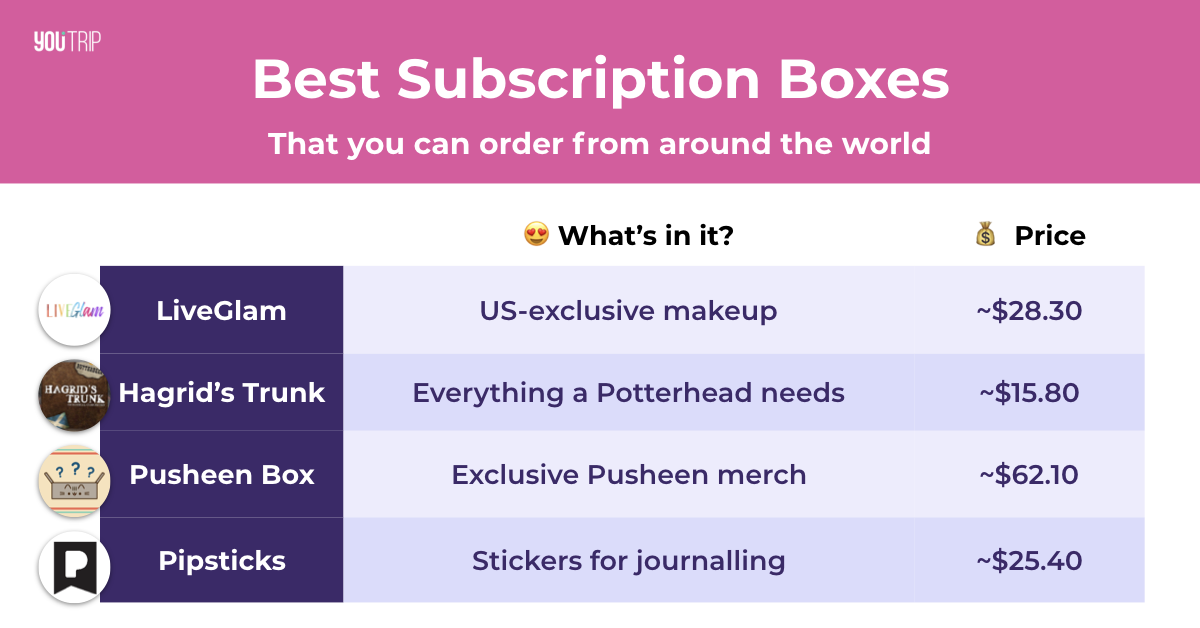Monthly sub boxes have taken the world by storm, offering a convenient and personalized way to discover new products and experiences. From beauty to snacks and hobbies, these subscription boxes cater to a wide range of interests and provide a unique way to connect with consumers.
In this comprehensive guide, we will explore the booming monthly sub box industry, discussing its various business models, marketing strategies, and operational challenges. We will also delve into the latest trends and innovations shaping this dynamic market, providing valuable insights for businesses and consumers alike.
Market Overview
The monthly subscription box industry has experienced remarkable growth in recent years, with a global market value estimated to reach USD 21.47 billion by 2025. This surge in popularity can be attributed to the convenience, discovery, and personalization offered by subscription boxes.
Subscription boxes cater to a wide range of interests, from snacks and beauty products to hobbies and niche collectibles. The variety of boxes available ensures that there is something for everyone, making them a popular choice for consumers seeking convenience and tailored experiences.
Benefits of Subscription Boxes
Subscription boxes offer several benefits that contribute to their popularity:
- Convenience:Subscription boxes eliminate the need for customers to spend time researching and purchasing individual products. They receive curated boxes delivered directly to their doorstep, saving them time and effort.
- Discovery:Subscription boxes introduce customers to new products and brands that they might not have otherwise discovered. This aspect of discovery enhances the overall customer experience.
- Personalization:Many subscription boxes offer customization options, allowing customers to tailor their boxes to their specific preferences. This personalization ensures that customers receive products that they are genuinely interested in.
Business Models

Monthly sub box companies employ a variety of business models to cater to different target audiences and market segments. These models include direct-to-consumer, wholesale, and licensing.
Direct-to-consumer (DTC) is a popular model where companies sell their subscription boxes directly to consumers through their own websites or e-commerce platforms. This approach allows companies to maintain complete control over the customer experience, build direct relationships with subscribers, and gather valuable data for marketing and product development.
Wholesale
In the wholesale model, sub box companies sell their products to retailers or distributors, who then sell them to consumers through their own channels. This model allows companies to reach a wider audience and benefit from the distribution network of established retailers.
However, it may result in lower profit margins and less control over the customer experience.
Licensing
Under the licensing model, sub box companies license their brand and product line to third-party companies that create and distribute the subscription boxes. This approach allows companies to expand their reach and generate additional revenue without having to manage the production and logistics of the subscription boxes themselves.
Each business model has its own advantages and disadvantages, and the choice of model depends on the specific target market, product offerings, and strategic goals of the company.
Marketing Strategies
Monthly sub box companies employ a range of marketing strategies to attract and retain subscribers. These include content marketing, social media marketing, and influencer marketing.
Content Marketing
Content marketing involves creating and distributing valuable, relevant, and consistent content to attract and engage a clearly defined audience. Monthly sub box companies use content marketing to educate potential subscribers about their products, build relationships with customers, and drive sales.
Examples of effective content marketing campaigns include:
- Creating blog posts and articles that provide information about the products and their benefits
- Developing videos that showcase the products in use
- Hosting webinars and live Q&A sessions to answer customer questions
Social Media Marketing
Social media marketing involves using social media platforms to connect with potential and existing customers. Monthly sub box companies use social media to promote their products, build relationships with customers, and generate leads.
Examples of effective social media marketing campaigns include:
- Running contests and giveaways on social media
- Partnering with influencers to promote the products
- Using social media advertising to target specific audiences
Influencer Marketing
Influencer marketing involves partnering with individuals who have a large following on social media to promote the products. Monthly sub box companies use influencer marketing to reach a wider audience and build credibility.
Examples of effective influencer marketing campaigns include:
- Sending free products to influencers to review
- Offering influencers a commission on sales generated through their unique referral links
- Hosting events and inviting influencers to attend
Measuring the Success of Marketing Campaigns
It is important for monthly sub box companies to measure the success of their marketing campaigns. This can be done by tracking key metrics such as:
- Website traffic
- Social media engagement
- Sales
- Customer lifetime value
Customer Acquisition and Retention
Monthly sub box companies employ various methods to acquire new customers, including paid advertising, organic search, and referrals. Paid advertising involves placing ads on search engines, social media, and other websites to reach potential customers. Organic search focuses on optimizing websites and content to rank higher in search engine results pages (SERPs), making it easier for customers to find the company’s products.
Referrals involve incentivizing existing customers to refer new customers, often through discounts or rewards.Customer retention is crucial for monthly sub box companies, as it reduces churn and increases customer lifetime value. Strategies for reducing churn include providing excellent customer service, offering flexible subscription options, and personalizing the customer experience.
Loyalty programs, which reward customers for repeat purchases, are also effective in retaining customers.Examples of loyalty programs include subscription discounts, exclusive product access, and early access to new products. Other initiatives used to retain customers include personalized recommendations, tailored content, and community engagement.
By implementing effective customer acquisition and retention strategies, monthly sub box companies can build a loyal customer base and drive long-term growth.
Paid Advertising
Paid advertising allows companies to reach a wider audience and target specific demographics. Common platforms for paid advertising include search engines (e.g., Google AdWords), social media (e.g., Facebook Ads), and display networks (e.g., Google Display Network).
Companies can use various ad formats, such as text ads, banner ads, and video ads, to promote their sub boxes.
Organic Search
Organic search is a cost-effective way to acquire customers through search engines. By optimizing their websites and content for relevant s, companies can improve their search engine rankings and increase organic traffic to their websites. This involves creating high-quality content, building backlinks, and optimizing website structure and performance.
Referrals
Referrals are a powerful way to acquire new customers through word-of-mouth marketing. Companies can incentivize existing customers to refer new customers by offering discounts, rewards, or other benefits. Referral programs can be managed through dedicated referral software or simply through manual tracking.
Customer Service
Excellent customer service is essential for reducing churn and retaining customers. This includes providing prompt and helpful support through multiple channels, such as email, phone, and live chat. Companies should also strive to resolve customer issues quickly and efficiently.
Flexible Subscription Options
Offering flexible subscription options allows customers to tailor their subscriptions to their needs and preferences. This can include options for different subscription lengths, frequencies, and product combinations. Companies should also consider offering a variety of payment methods to accommodate different customer preferences.
Personalized Customer Experience
Personalizing the customer experience can help build relationships and increase customer satisfaction. This can involve using customer data to provide tailored recommendations, offering personalized content, and creating a sense of community around the brand.
Loyalty Programs
Loyalty programs reward customers for repeat purchases and encourage them to continue subscribing. Common types of loyalty programs include subscription discounts, points-based rewards, and exclusive product access. Companies should design loyalty programs that are easy to understand and offer valuable rewards to customers.
Community Engagement
Building a community around the brand can help retain customers and foster a sense of loyalty. This can involve creating online forums, hosting events, and engaging with customers on social media. Companies should encourage customers to share their experiences, provide feedback, and connect with other subscribers.
Content Creation and Curation

Crafting and curating exceptional content is the cornerstone of successful monthly sub boxes. It’s not just about filling boxes with products; it’s about creating a cohesive and engaging experience that keeps subscribers coming back for more.
To achieve this, consider the following tips:
Engaging and Informative Content
- Develop content that resonates with your target audience. Understand their interests, passions, and aspirations.
- Provide value by offering insights, tips, tutorials, and exclusive behind-the-scenes glimpses.
- Use a variety of formats, such as articles, videos, infographics, and interviews, to cater to different learning styles.
User-Generated Content
Empower your subscribers by encouraging them to share their experiences and feedback. This creates a sense of community and fosters brand loyalty.
- Host contests and giveaways that encourage subscribers to share photos or videos of their unboxing experiences.
- Feature subscriber testimonials and reviews on your website or social media channels.
- Create a dedicated platform or hashtag for subscribers to connect and interact with each other.
Logistics and Operations
Monthly sub box companies face unique logistical and operational challenges, including inventory management, shipping, and customer service. Optimizing these processes is crucial for improving efficiency and reducing costs.
Inventory Management
Managing inventory effectively is essential to ensure timely order fulfillment and avoid overstocking or stockouts. Sub box companies must implement robust inventory tracking systems, establish optimal inventory levels, and forecast demand accurately.
- Centralized Inventory Management:Use a single system to track inventory across multiple locations, providing real-time visibility and reducing the risk of stock discrepancies.
- Demand Forecasting:Utilize data analytics to predict future demand based on historical sales patterns, seasonality, and marketing campaigns.
- Just-in-Time Inventory:Minimize inventory holding costs by ordering products only when needed, based on accurate demand forecasts.
Shipping and Fulfillment
Efficient shipping and fulfillment processes ensure timely delivery and minimize shipping costs. Sub box companies should optimize packaging, negotiate competitive shipping rates, and consider outsourcing fulfillment to third-party providers.
- Optimized Packaging:Use custom-sized boxes to reduce shipping costs and minimize environmental impact.
- Shipping Rate Negotiation:Negotiate volume discounts and explore partnerships with multiple carriers to secure competitive shipping rates.
- Outsourcing Fulfillment:Partner with third-party fulfillment providers to handle order processing, packaging, and shipping, freeing up internal resources.
Customer Service
Exceptional customer service is vital for retaining subscribers and building a loyal customer base. Sub box companies should establish efficient communication channels, respond promptly to inquiries, and resolve issues effectively.
- Multiple Communication Channels:Provide multiple channels for customers to reach support, including email, phone, live chat, and social media.
- Rapid Response Times:Establish service level agreements (SLAs) for response times and ensure prompt resolution of customer queries.
- Personalized Support:Tailor customer support to individual subscriber needs, addressing specific issues and providing personalized solutions.
Technology and Innovation: Monthly Sub Boxes
Technology plays a pivotal role in the monthly sub box industry, enabling companies to streamline operations, enhance the customer experience, and drive growth. Subscription management software automates tasks such as order processing, inventory management, and customer communication, reducing manual labor and improving efficiency.
Data analytics provides valuable insights into customer behavior, preferences, and trends. This information can be used to personalize subscription boxes, offer tailored recommendations, and optimize marketing campaigns. Additionally, mobile apps and online platforms offer convenience and accessibility for customers to manage their subscriptions and track shipments.
Innovative Technologies
- Artificial Intelligence (AI):AI-powered chatbots and virtual assistants provide 24/7 customer support, answer queries, and offer personalized recommendations.
- Augmented Reality (AR):AR apps allow customers to preview products in their homes before subscribing, enhancing the shopping experience.
- Blockchain:Blockchain technology ensures secure and transparent transactions, tracking subscription payments and product authenticity.
Trends and Future Outlook
The monthly sub box industry is constantly evolving, with new trends emerging all the time. Some of the key trends that are shaping the industry include:
- The rise of personalized and niche boxes:Consumers are increasingly looking for boxes that are tailored to their specific interests and needs. This has led to a proliferation of niche boxes, such as boxes for foodies, beauty enthusiasts, and gamers.
- The growing popularity of sustainable and ethical products:Consumers are becoming more aware of the environmental and social impact of their purchases. This has led to a growing demand for boxes that contain sustainable and ethical products.
- The use of technology to enhance the customer experience:Subscription boxes are increasingly using technology to improve the customer experience. This includes using apps to track shipments, manage subscriptions, and provide personalized recommendations.
These trends are likely to continue to shape the industry in the future. In addition, we can expect to see new trends emerge, such as the use of artificial intelligence to personalize boxes and the growth of subscription boxes for specific demographics, such as seniors or children.
Challenges and Opportunities, Monthly sub boxes
The monthly sub box industry faces a number of challenges, including:
- Competition:The industry is becoming increasingly competitive, with new boxes being launched all the time. This can make it difficult for boxes to stand out from the crowd.
- Customer churn:Subscription boxes have a high churn rate, meaning that customers often cancel their subscriptions after a few months. This can make it difficult for boxes to build a sustainable business.
- Shipping costs:Shipping costs can be a significant expense for subscription boxes. This can make it difficult for boxes to offer free shipping or keep their prices low.
Despite these challenges, there are also a number of opportunities for the monthly sub box industry. These include:
- Growth potential:The industry is still relatively young and has a lot of room for growth. This is especially true in emerging markets.
- Innovation:The industry is constantly innovating, with new boxes and new ways to improve the customer experience being launched all the time. This keeps the industry fresh and exciting.
- Customer loyalty:Subscription boxes can build strong customer loyalty. This is because customers who love their boxes are likely to continue subscribing for months or even years.
Predictions for the Future
The future of the monthly sub box industry is bright. The industry is expected to continue to grow in the coming years, and new trends are likely to emerge. Here are a few predictions for the future of the industry:
- Subscription boxes will become more personalized:Boxes will be increasingly tailored to the specific interests and needs of individual customers.
- Subscription boxes will become more sustainable:Boxes will increasingly contain sustainable and ethical products.
- Subscription boxes will become more interactive:Boxes will use technology to enhance the customer experience, such as by providing personalized recommendations and allowing customers to track their shipments.
The monthly sub box industry is a dynamic and exciting industry. It is an industry that is constantly evolving, and it is an industry that is poised for continued growth in the years to come.
Ultimate Conclusion

As the monthly sub box industry continues to evolve, it presents both challenges and opportunities for businesses and consumers. By embracing innovation, personalization, and sustainability, monthly sub boxes will undoubtedly remain a popular and rewarding way to connect with customers and discover new products and experiences.
Detailed FAQs
What are the benefits of subscribing to a monthly sub box?
Monthly sub boxes offer a range of benefits, including convenience, discovery, personalization, and exclusivity.
How do monthly sub box companies acquire new customers?
Monthly sub box companies use a variety of methods to acquire new customers, including paid advertising, organic search, social media marketing, and influencer marketing.
What are the key challenges faced by monthly sub box companies?
Monthly sub box companies face a number of challenges, including inventory management, shipping, customer service, and competition.